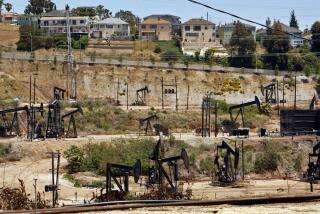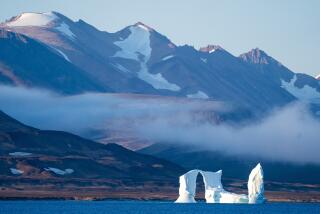Arctic Drilling Study Cites Wildlife Risk
SEATTLE — Oil development in the Arctic National Wildlife Refuge, the keystone of President Bush’s energy strategy, poses a potential threat to caribou and other wildlife that already are fighting the effects of Arctic warming, government scientists concluded Friday.
In a long-awaited review of the environmental consequences of oil drilling in the northern Alaskan refuge, biologists for the U.S. Geological Survey said oil development would “most likely” restrict the area available for caribou calving. This would lead to impaired reproduction and calf survival for the 123,000 caribou that flock each spring to the refuge’s 1.5-million-acre coastal plain to bear their young.
The scientists considered a range of oil development scenarios, but many of the conclusions did not identify each scenario’s results, leaving the report’s findings open to interpretation.
The administration quickly moved to downplay the findings, pointing out that the heaviest threats are likely posed by development scenarios that are much more substantial than Congress is considering. But drilling opponents said the report lays out realistic consequences of development on the fragile tundra.
“The Bush administration believed this scientific study would revive their sagging case for drilling in the pristine Arctic. Now that their pseudo-environmental arguments have been exposed as little more than big oil’s wishful thinking, the administration should . . . finally put aside plans to drill in the pristine wilderness of the Arctic,” said Sen. John F. Kerry (D-Mass.), who has threatened a filibuster if Arctic drilling is inserted into Senate energy legislation likely to be debated in the coming weeks.
In fact, the effects could be either substantial or almost nonexistent depending on the level and location of oil development, said Bill Seitz, the USGS’ deputy regional director in Alaska.
“This is probably the first time we’ve brought some up-to-date information that tries to quantify what some of these impacts are going to be,” Seitz said. “Some scenarios have no impact at all. One [with the heaviest effects] looks at full-blown development. But I think everyone would agree now that development . . . is going to be something much smaller, and much less intrusive.”
Study Started in the 1980s
The USGS often works closely with the oil industry, preparing federal oil and gas estimates. The team of biologists that prepared the report, relying on the work of dozens of independent researchers, began its study in the 1980s, when it was part of the U.S. Fish and Wildlife Service.
Their analysis looked at five scenarios, ranging from draining the oil pool on the border between ANWR and the existing Prudhoe Bay oil field, which would have relatively little effect on the refuge, to full oil and gas leasing throughout the coastal plain, including building permanent roads and an airport.
Interior Secretary Gale A. Norton has emphasized that ANWR oil, estimated at 5.7 billion to 16 billion barrels, could lessen dependence on foreign oil.
Interior spokesman Mark Pfeifle said the report underscores that the effects on wildlife can be minimal with appropriate mitigation.
“The report bolsters the administration’s mandate that production in the ANWR area must require the most significant environmental protections ever imposed on energy production,” Pfeifle said.
House Proposal Highly Restrictive
Pfeifle said none of the development scenarios studied by the USGS is as limiting as the restrictions passed by the House of Representatives last year; it would restrict development to 2,000 acres.
Presumably, that would be located in the northwest corner of the coastal plain, where most of the oil is believed to be. Additionally, techniques such as ice roads and slant drilling would minimize any harm, he said.
USGS Director Charles G. Groat said Friday that he has asked the scientists to analyze within the next 10 days the effect of more limited oil development.
Some caribou scientists said it would be difficult to quickly analyze development limited to the northwest end of the coastal plain because little data of that kind exist.
Drilling opponents doubt that limiting oil development to the northwest quadrant would provide substantial benefits. Most of the polar bear dens on the coastal plain are located there, for example. And the Sierra Club says a 2,000-acre footprint under consideration could still support a broad level of development.
“We did one scenario that was consistent with the 2,000-acre footprint, and it would sustain 53 drilling pads and 250 miles of roads and pipelines,” Carl Pope, executive director of the Sierra Club, said in an interview.
“What this [USGS] study shows is what every previous study has shown, that turning this refuge over to the oil industry will have very damaging effects on its use as wildlife habitat,” Pope said.
Advocates for oil development in the refuge said they would not take the study seriously as long as it failed to consider the true, limited scope of oil activity now being contemplated.
“It’s a report that’s based on very fictional development scenarios,” said Kim Duke, executive director of Arctic Power, an Anchorage-based drilling lobby group. “They’ve taken a worst-case scenario with a great part of this report, but even that can be mitigated. Thirty years of development in Prudhoe Bay has shown no adverse impacts on wildlife.”
In fact, the USGS report points as an example to the caribou herd at Prudhoe Bay, whose numbers have been robust but whose calving activity has been significantly displaced by oil fields.
Similar displacement for ANWR’s Porcupine caribou herd would be difficult because the coastal plain is much narrower within the refuge, and the herd may be “particularly sensitive” to oil development, the report concluded.
Arctic Is Warmed by Climate Shift
It is “remotely conceivable” that caribou could find new calving areas with equally good food supplies and protection from predators, but it is “quite unlikely,” it said.
A general climate shift has warmed up the Arctic summers over the last several years, providing longer periods of green forage but also producing unusual freeze-thaw events in the spring that have made it difficult for caribou to reach the calving grounds--a significant stress for the herd, the researchers found.
A further problem, biologists noted, is the relative weakness of the Porcupine herd, which has been in a steady cyclical decline from a peak of 178,000 in 1989 to 123,000 today.
Dwindling Caribou Numbers Feared
The herd could reach the lowest levels ever recorded from 2005 to 2010--just when oil development would be getting underway, the report said.
“An example we like to give is that on average, if we decreased calf survival by 5%, the herd wouldn’t grow or recover from declines like it’s in now,” said caribou biologist Ken Whitten, who was a junior author on the report.
“The point being, it wouldn’t take much,” Whitten said. “It doesn’t have to be a catastrophic change in calf survival to have an effect on the herd.”
The report also said the lumbering musk oxen that live in the refuge are “particularly vulnerable” to disturbance during the winter months, when oil road building and construction are busiest.
The wind and snow leave the animals with little food or energy to move away from the oil activity.
“Musk oxen . . . are vulnerable to disturbance from activities associated with petroleum exploration and extraction because of their year-round residency, their small population numbers and their need to conserve energy for the nine months of winter if they are to successfully reproduce,” the report said.
About 43% of the Beaufort Sea’s land-based polar bears den within the Arctic refuge. But studies have shown these bears are rarely disturbed by outside activity, the report said.
“Aggressive and proactive management, therefore, can minimize or eliminate most of the potential adverse effects of human developments on denning polar bears,” it said.
More to Read
Sign up for Essential California
The most important California stories and recommendations in your inbox every morning.
You may occasionally receive promotional content from the Los Angeles Times.










